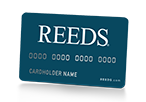This is a demo store. No orders will be fulfilled. (1368487-reeds-pro-web-1.reeds.com)
Your Most Common Engagement Ring Questions
Our Jewelry Consultants Weigh In
Not to toot our own horn, but we’ve been trusted for 75 years when it comes to engagement ring advice and believe us, we’ve heard all the questions. In the spirit of helpfulness, our Jewelry Consultants has compiled the most-asked questions for you to browse, learn, and get next-level comfy with some diamond and ring knowledge.
No question is too big, small, or silly—but if you can’t find your specific question (or you’re just super social and want to chat) get in touch directly with our Jewelry Consultants, a GIA-certified expert who can deftly guide you through thousands of options to find your perfect one-and-only or even help you design a ring from scratch. And hey, they might have some proposal ideas while they’re at it! Consultations are free, so book yours here.
Most-Asked Engagement Ring Questions
Most-Asked Engagement Ring Questions


Couple of things here.
Engagement rings are usually made from a variety of durable metals like gold, platinum, titanium, and more. You won’t typically find a silver engagement ring, and here’s why—since this ring will be worn daily for forever-and-ever-amen, silver is a bit too soft.
You’ll want to choose a metal that can withstand daily wear and tear with minimal scratching, etc (hence the popularity of gold and platinum). Perhaps when you say silver, you actually mean the white color tone—in which case white gold or platinum would fit the bill. You can find engagement rings in a variety of colors, so take a browse at all your options.
Nope.
An engagement ring is the key player during a proposal, when the proposer presents it (along with the popped question) to the proposee. The wedding rings are the rings that are exchanged along with vows during the actual wedding ceremony.
But they do share some overlapping meaning—both are a symbol of love and commitment.




We’ve had no problem sizing up or down but to be sure it’s best to take your ring to your local REEDS and ask an expert there for guidance based on your individual ring.
There could be exceptions depending on the ring’s setting and stone placement (like an eternity band that has stones going all the way around—that couldn’t be resized).
Western tradition dictates that the ring should be worn on the ring finger of the left hand.
This is because at one point people believed that the vein there led directly to the heart. Turns out that actually isn’t true, but the romantic sentiment is stronger than any anatomy discovery, so we’re still all for it.




The easy answer is just “forever ago."
Some people say it began in ancient Rome, and the rings were made of flint and bone. Another story is that the first diamond engagement ring made its debut around 1477 when Archduke Maximillian of Austria commissioned a ring for Mary of Burgundy. This spurred a diamond ring trend among the aristocracy that eventually influenced us all.
This is definitely a case of ‘to each his/her/their own’.
But there are plenty of ways you can figure out which kind you’ll love forever. Consider these few things: your style (do you love vintage looks or are you the trending type? Classic or glam?), your lifestyle (higher settings can get in the way if you wear gloves often or are active, for example), and what’s caught your eye in the past—is there a certain stone shape or precious metal you gravitate towards?
Jot down all these answers and start your search from there. You can also chat with one of our experts online or at your local REEDS—just tell them a bit about yourself and they can offer their best suggestions.




Care is super simple—just use warm water and some gentle dish soap to clean your diamond and keep it bright and sparkling.
You’ll also want to make sure that the ring’s integrity stays 100%, so bring it into the store once a year and have the jeweler give it a quick check to make sure the stone is secure in the mounting.
You’ll want to brush up on what the diamond savvy call the 4 Cs—color, cut, clarity, and carat.
Each of these affects the appearance and potentially the value of your stone, so they’re important to know. (We have a whole guide dedicated to it here!) Aside from that foundational knowledge, you’ll absolutely want to make sure you’re shopping with someone you trust, who will be honest and transparent in their guidance and pricing. (Like *ahem* your local REEDS.)




The most important thing to consider is your budgetary comfort level.
But also remember this is likely the single most important jewelry purchase of your life, and it will last a lifetime (maybe even passing through generations beyond) and carry a huge sentimental significance. So it’s worth an investment. If you’re looking for a specific estimate, three month’s salary is a suggestion floating around—but you’ll want to weigh that against your financial circumstances as a couple and make a call.
Totally up to you.
Some people never do, others want to keep with changing styles or swap out one they no longer love. It all comes down to how sentimental and attached to your ring you are. One idea is to keep the center diamond and remount it in a different semi-mount or even another piece of jewelry, like a pendant.
If you want to upgrade to something brand new, you can trade in your diamond at REEDS for full value toward a purchase of greater value. REEDS will let you trade your mined diamond for another mined diamond and your lab-grown diamond for another lab-grown diamond. Your local REEDS jeweler can take a look and let you know what yours would be worth, or suggest a new setting.


There you have it—engagement ring and lab grown diamond 101 complete. Still have questions or want some help navigating the huge oceans of rings out there? Don’t forget to set up a complimentary consultation and help sesh with our Jewelry Consultants here. Or just visit your local REEDS to explore in person and get instant expert advice.
(Find your local store here!)
Yes, depending on the style.
They can be, depending on the watch. Some brands are a better investment than others—now-vintage styles from Rolex, Cartier, and Omega can command impressive prices and see their value soar quickly in a short period of time. “Wrist shots” on social media are driving demand and popularity for collecting vintage watches, as are celebrities (a Paul Newman-model Rolex Daytona from the 1960s showed up on Ellen DeGeneres’ wrist on one television show, estimated value is whooping at around $250,000).
While vintage and pre-owned styles might be the rage right now, the new watches being produced today are tomorrow’s collectors’ items—so holding onto them for a long time is likely to increase your initial investment, if you choose the right brand and style. While the patina of watches from the 60s adds to their cool factor, today’s watches are made with astoundingly better materials (think indestructible ceramics versus the scratch-prone acrylic of yesteryear). So chances are your modern watch will (quite literally) stand up to the test of time.
There are three different types of movements that make a watch work—quartz, mechanical, and automatic. A quartz watch is battery operated, which makes the second hand move in individual ticks (interestingly, solar-powered watches like the Citizen Eco-Drive are considered quartz).
In contrast (and in lieu of a battery), a mechanical watch is manually wound and has a smooth second hand motion. The benefit here is that you never run out of energy (considering you wind it regularly) and there are no batteries to be disposed of for the environment’s sake. Mechanical watches can be traditional-looking and rugged (check out the Hamilton Khaki Field collection) or completely modern—Tissot’s mechanical T-Complication Squelette model shows off a skeleton dial, which allows you to see through to the inner workings of the watch.
An automatic watch uses the energy from the movement of the watch wearer’s wrist to automatically drive the mechanisms within the timepiece. With automatic function, the key benefit is longevity—so long as you wear it regularly so it has the ability to borrow your energy. This type of watch is offered by a range of brands, from Breitling and Bulova to TAG Heuer and Accutron.
We can trace the modern watch back to the workshop of a locksmith and clockmaker in 16th century Switzerland—Peter Henlein is credited with crafting the first watch there. And so an industry was born, and one particularly associated with luxury, precision, heritage and the epitome of detail. Today, a watch crafted in Switzerland can be called a Swiss watch and is held to an exceptional standard of quality, design, and craftsmanship. Luxury Swiss watch brands are now almost synonymous with cutting-edge technology and materials.





It depends on the extent of damage or what the issue is—many parts can be replaced and other issues fixed by our watch repair specialist. But if your watch was run over by a car, you may be out of luck. Check out REEDS Watch Care Plans, which cover many types of repairs and give you peace of mind every time you strap on your investment.
There are a number of reasons depending on the watch in question, but they usually fall into a couple of categories. At the top of the list is brand association and exclusivity—many watchmakers intentionally make limited production runs, which drives up demand and value.
But there are also quality details that affect the price—innovative technology takes time to research and develop, and some watches are meticulously (meaning slowly and painstakingly) crafted or finished by hand rather than on a machine’s assembly line.
And of course, there’s the material question. If your timepiece is encrusted in diamonds and gleaming in gold, obviously there’s going to be a higher price tag—and also a better chance of holding value into the future.
When you consider that watches function as more than just practical timepieces (they’re style statements and pieces of nostalgia, too) we don’t believe watches are going anywhere anytime soon. In fact, like we mentioned earlier, social media is creating even more interest and newbie watch collectors. There’s also the sentimental component of timepieces being passed down from generation to generation.
This isn’t a hard and fast rule and is really best determined by personal preference. Since most people are right handed and use that as their dominant hand, wearing the watch on the left wrist made more sense comfort-wise and also helped limit the risk of damage to the watch.
Waterproof is a misnomer—the industry prefers the term water resistant, because ‘waterproof’ implies a level of warranty that watches cannot obtain. These guidelines are issued by the Federal Trade Commission of the U.S. There are different levels of water resistance, ranging from basic humidity or drizzle protection all the way to 200m or 300m, making it suitable for scuba diving. Water can damage watches with lower resistance ratings, so it’s an important factor to consider and investigate based on your lifestyle and activities as you’re watch shopping.
A quality watch should last a lifetime, and with a little care and regular maintenance, it’s easy to achieve. First, make sure you’re avoiding water (based on your watch’s recommended resistance level) and any chemical exposure. Keep it clean by gently polishing and if it’s mechanical, make sure you’re winding it regularly. REEDS offers a Watch Care Plan that offers two years of repairs and service to keep your watch ticking like new—including repairs from bezel to band and clasp to crown. Find out more details here.


